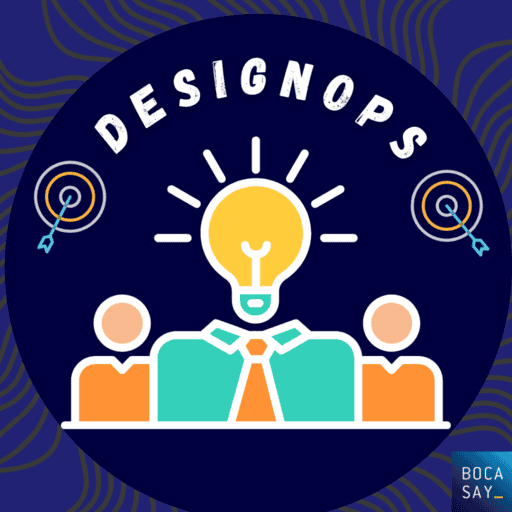What are the benefits of DesignOps?
Today, companies are realizing the importance of digital experiences to strengthen customer loyalty and understand the value of creativity, empathy and innovation as part of winning strategies.
These companies are investing in increasing their design capabilities to stay competitive in a fast-changing world.

What is DesignOps?
As the name suggests, DesignOps is an attempt to operationalize design. DesignOps is a dedicated team (depending on the size of the company, it can be a single person or a department) that manages the design process within an organization.
The primary goal of DesignOps is to establish a highly efficient design process that generates high quality design results. DesignOps creates benefits for everyone involved in the design process, not necessarily just the designers.
Their approach is human-centered and aimed at creating stronger design teams that support the orchestration of people, processes and tools to amplify creativity.
Similar to DevOps, which revolutionized the development process through an agile and iterative approach, DesignOps enables companies to rapidly evolve and iterate design processes across teams.
DesignOps work around these four pillars:
1. The design process
2. Team coordination
3. The design tools
4. The design culture
Why is DesignOps so important today?
Whenever a team, department, or company grows, the added complexity creates an extra workload. Decisions are slowed down and employees can become frustrated by organizational tensions and lack of clear communication between teams. These frictions require a new way of managing projects that increases efficiency throughout the organization.
Introducing a DesignOps role is not only a structural change, but also a cultural change. Our understanding of the design process is evolving, and we no longer want to separate different teams. Instead, we want designers, developers, researchers, and other team members to work together during the design process, and the DesignOps team makes that possible.
DesignOps define and execute a cohesive vision for the organization’s design processes. The goal is to increase communication between teams and reduce tension in service of creating user-centered design. Implementing DesignOps requires both a mindset and a set of guiding principles to enable an organization to increase effective collaboration.
𝔸𝕣𝕖 𝕪𝕠𝕦 𝕝𝕠𝕠𝕜𝕚𝕟𝕘 𝕗𝕠𝕣 𝕒 𝕡𝕒𝕣𝕥𝕟𝕖𝕣 𝕔𝕒𝕡𝕒𝕓𝕝𝕖 𝕠𝕗 𝕡𝕣𝕠𝕕𝕦𝕔𝕚𝕟𝕘 𝕙𝕚𝕘𝕙 𝕢𝕦𝕒𝕝𝕚𝕥𝕪 𝕀𝕋 𝕕𝕖𝕧𝕖𝕝𝕠𝕡𝕞𝕖𝕟𝕥 𝕗𝕠𝕣 𝕪𝕠𝕦𝕣 𝕔𝕠𝕞𝕡𝕒𝕟𝕪? 𝕐𝕠𝕦 𝕙𝕒𝕧𝕖 𝕔𝕠𝕞𝕖 𝕥𝕠 𝕥𝕙𝕖 𝕣𝕚𝕘𝕙𝕥 𝕡𝕝𝕒𝕔𝕖, 𝕕𝕚𝕤𝕔𝕠𝕧𝕖𝕣 𝕠𝕦𝕣 𝕥𝕖𝕒𝕞 𝕠𝕗 𝕕𝕖𝕧𝕖𝕝𝕠𝕡𝕖𝕣𝕤
What are the benefits of integrating a DesignOps service into an enterprise?
1. Let your designers focus on design
While this may seem obvious, as we mentioned earlier, some companies still expect designers to play multiple roles. Sometimes a single designer will juggle several tasks at once:
- conducting user research,
- designing the information architecture,
- thinking about the user interface,
- and handling the writing of the user interface.
While this approach may work well for a small team or an early-stage startup, keep in mind that it is not scalable. In the long run, burdening designers with other tasks can detract from the quality of their work.
2. Check the efficiency of your design process
With a DesignOps, you can find and eliminate inefficiencies in the design workflow. This allows your design team to do more with less time and resources. Therefore, by optimizing the team’s work and performance, you may avoid unnecessary hires.
3. Use tools for efficient remote product design
While in small organizations, collaboration between designers can happen organically, this is not the case for larger (and especially remote) teams. To collaborate effectively, it’s important to equip your designers and other product development team members with the right set of tools. This is where DesignOps software adds immense value.
4. Establish collaboration routines
Collaboration routines, such as daily standups or weekly meetings, which are typically practiced by agile teams, encourage your designers to share regular status updates and – if necessary – ask for help.
5. Ensure that all designers have a career path to advance
While recruiting people with the right skills is no easy task, retaining them is even less so. Fortunately, DesignOps practices can help address these challenges by creating clear career paths. As the design process matures, the team can offer more specialized roles that will allow designers to learn new skills. Meanwhile, more experienced individuals will have the opportunity to be promoted to more senior positions.
6. Break down silos for cross-team information sharing
Breaking down silos is perhaps the most important reason to implement information sharing systems as part of your DesignOps strategy. To illustrate its importance, let’s refer again to an analogy from the world of software development operations (DevOps).

How do I integrate a DesignOps branch into my company?
As you onboard new staff and expand your teams, you’ll need to educate them on the value and role that design plays in your business. You need to create a consistent message that can be proactively shared with all internal teams, outsourced teams and design partners. There are several ways to integrate a DesignOps branch.
Some companies may choose to hire a dedicated DesignOps manager to facilitate communication and oversee the entire UX development process. This manager doesn’t need to be an incredibly talented designer in any particular specialty themselves, but they should have a deep understanding of what makes an overall design truly user-centric.
Successful DesignOps professionals bring an operational perspective and project management skills to design processes as they oversee design workflows, governance, and budget. They will develop lines of communication across the organization that reduce friction and acculturate the organization to value UX design.
On the other hand, hiring a dedicated DesignOps manager may be incompatible for some organizations or a design team may be too small to justify such a hire. However, that doesn’t mean they are unable to begin cultivating a DesignOps culture. Business leaders can start working to increase communication and collaboration. One way to do this is to create a repository of common elements that can be used and reused by teams and serve as a centralized reference point.
Any way that organizations can break down the silos between UX teams contributes to successful DesignOps integration.
Companies today are facing more and more challenges: customers are becoming more demanding, new products are being launched faster, and product life cycles are getting shorter. One solution is to introduce DesignOps. Not only will it improve your design workflow, but it will also allow designers to focus on what they do best – designing digital products.